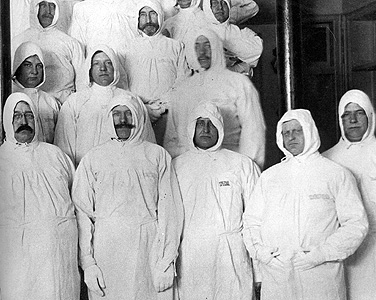Flashback
90 years ago
UB fights the flu

The influenza epidemic of 1918-19 killed more than 550,000 Americans and 20 million people worldwide. Occurring during World War I, it dwarfed the staggering U.S. death toll of 116,516 in that war. Only the Bubonic Plague of 540-558 A.D. and the Black Death during the 14th century were more deadly.
During the flu epidemic, Buffalo weathered the biological storm better than most cities, possibly due to the leadership of the University of Buffalo Medical School and its local alumni. The photo here depicts Buffalo physicians garbed to reduce the risk of contagion as they tended to their patients.
The acting health commissioner for Buffalo at the time, Franklin C. Gram, MD ‘91, formed a special advisory committee to deal with the epidemic. Hospitals were required to dedicate half their beds to influenza cases, and Buffalo’s Central High School was converted into a temporary hospital. On Oct. 16, 1918, the senior class of the medical school was pressed into service, and the next day, the members of the junior and sophomore classes were called for special duties.
Also that month, Gram imposed draconian measures on the citizens of Buffalo that virtually shut down the city for weeks. Assemblies of more than 10 people were prohibited. Streetcars, theaters, schools, church services, funerals and even saloons were shut down. The university canceled all classes—except military classes—and prohibited football games with out-of-town schools. Citizens wore gauze masks and wartime troops moving through the city were thought to spread the disease. Buffalo’s strict public health measures worked: The city suffered only a 6 percent morbidity rate as compared to 10 percent nationwide.
Source: Another Era: A Pictorial History of the School of Medicine and Biomedical Sciences, State University of New York at Buffalo 1846-1996. Virginia Beach: Donning Company Publishers, 1996.
The original photograph, reproduced in Another Era, is from the collections of the Buffalo and Erie County Historical Society.
—Judith Adams-Volpe, University Libraries

Reader Comments